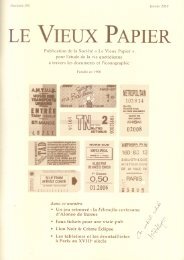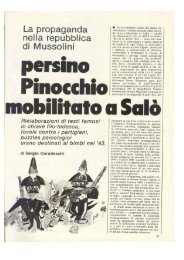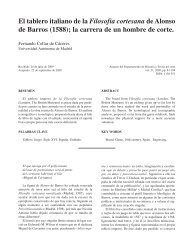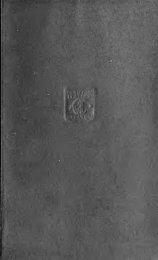Board games from the city of Vijayanagara (Hampi ... - Gioco dell'Oca.
Board games from the city of Vijayanagara (Hampi ... - Gioco dell'Oca.
Board games from the city of Vijayanagara (Hampi ... - Gioco dell'Oca.
You also want an ePaper? Increase the reach of your titles
YUMPU automatically turns print PDFs into web optimized ePapers that Google loves.
R.VASANTHA, BOARD G AMES FROM THE C ITY OF V IJAYANAGARA 33<br />
Fig. 12. Pagade kayi ata or Pachikala ata<br />
too. Also played on special occasions. The ladies <strong>of</strong> <strong>the</strong> younger generation are nei<strong>the</strong>r<br />
aware <strong>of</strong> <strong>the</strong> game nor know to draw <strong>the</strong> board. Slowly it is getting extinct.<br />
• This is played on <strong>the</strong> wooden board, cloth board or drawing on <strong>the</strong> floor.<br />
• Presenting this game-board set to <strong>the</strong> daughter as a marriage gift by <strong>the</strong> mo<strong>the</strong>r still<br />
exists in this region (North Karnataka).<br />
• Playing pieces are made <strong>of</strong> shells, cowries, and specified pawns indicative <strong>of</strong> four<br />
colours or sizes or shapes.<br />
• Played with ei<strong>the</strong>r dice or cowries.<br />
• To highlight more details a separate paper and session is necessary.<br />
6. Single-track <strong>games</strong><br />
Figs. 13, 14, 15.<br />
No local names<br />
Locally no one is aware <strong>of</strong> this game and it is not played any longer.<br />
Locations: 1. Hemakuta-Jaina temples, 2. under <strong>the</strong> big boulders, 3.underground<br />
temple, 4. Hazara Rama temple, 5. Vitthala temple, 6. Pattabhi Rama temple, 7.<br />
Practically everywhere<br />
The track is set out as a series <strong>of</strong> cells with right angle turns; a square or a series <strong>of</strong><br />
dotted holes <strong>of</strong> 5x5 cells forms a looped circuit; cross-cut cells (representing safe squares)<br />
occur at <strong>the</strong> corners and at <strong>the</strong> junction <strong>of</strong> <strong>the</strong> right angle turns.<br />
The lines are formed by a series <strong>of</strong> lightly pecked dots, and sometimes <strong>the</strong> surface is<br />
worn. It is possible, however, to infer how <strong>the</strong> game might have been played because <strong>of</strong><br />
its similarities to o<strong>the</strong>r recorded Asian <strong>games</strong>.<br />
The idea <strong>of</strong> <strong>the</strong> game was probably for two equal teams (two, four, six persons, etc.)<br />
to race along <strong>the</strong> track starting <strong>from</strong> <strong>the</strong> opposing crosscut squares, <strong>the</strong> first player to







